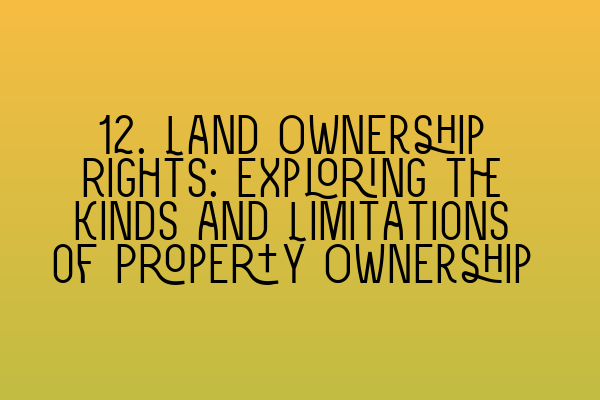Land Ownership Rights: Exploring the Kinds and Limitations of Property Ownership
When it comes to real estate law, understanding land ownership rights is crucial. Whether you are buying, selling, or leasing property, having a grasp of the different kinds of property ownership and their limitations can make all the difference in ensuring a smooth and legally sound transaction.
In this article, we will explore the various types of property ownership and shed light on the limitations that may come with each type. This knowledge will empower you to make informed decisions and navigate property law with confidence.
1. Freehold Ownership
Freehold ownership, also known as fee simple ownership, is the most complete form of land ownership. When you own a property in freehold, you have full and absolute ownership rights. This means you have the right to use, occupy, and dispose of the property as you see fit, within the boundaries of the law.
However, it is important to note that even freehold ownership comes with certain limitations. For example, you must adhere to local zoning regulations and obtain planning permission for certain land use and development activities. Additionally, there may be easements or rights of way that impact your rights as the landowner.
If you are preparing for the SQE 1 exam and need practice questions to test your knowledge of property law, check out these SQE 1 Practice Exam Questions.
2. Leasehold Ownership
Leasehold ownership is a form of property ownership where you have the right to use and occupy the land for a specified period. In leasehold ownership, the land is owned by another entity, such as a landlord or the freeholder, while you hold a lease or tenancy agreement.
Leasehold ownership often applies to residential or commercial properties that are part of a larger development or complex. As a leaseholder, you have specific rights and obligations outlined in the terms of your lease. These may include payment of ground rent, service charges, and adherence to certain covenants.
It is important to thoroughly review the terms of your lease before entering into a leasehold ownership arrangement. If you need assistance in understanding the legal implications of your lease, consider enrolling in SQE 1 Preparation Courses to enhance your knowledge of property law.
3. Co-ownership
Co-ownership occurs when two or more individuals jointly own a property. There are two common forms of co-ownership: joint tenancy and tenancy in common.
In joint tenancy, each co-owner has an equal share of the property, and if one owner passes away, their share automatically passes to the surviving co-owners. This is known as the right of survivorship. Joint tenancy is often common among spouses or partners who wish to own property together.
Tenancy in common, on the other hand, allows for unequal shares of ownership. Each co-owner has a distinct and separately transferable share, which they can pass on to heirs upon their death. Tenancy in common is often preferred when co-owners want to maintain individual control over their share of the property.
If you are looking for a comprehensive preparation resource for the SRA SQE exam, consider exploring SQE 2 Preparation Courses that cover various areas of property law and other relevant topics.
4. Limited Ownership
In some cases, land ownership rights may be limited due to specific arrangements or legal restrictions. One example of limited ownership is land held in trust.
When land is held in trust, the legal title is held by a trustee who manages and administers the property for the benefit of another individual or entity, known as the beneficiary. The trustee has a fiduciary duty to act in the best interests of the beneficiary and can only exercise their rights within the parameters set out in the trust agreement.
Another form of limited ownership is leasehold enfranchisement, which allows leaseholders to collectively purchase the freehold of their property. This gives them greater control over the management and maintenance of their land. Understanding the limitations and processes involved in leasehold enfranchisement can be crucial for leaseholders looking to exercise their rights.
If you are seeking guidance on property law exam dates and preparation, visit this page for up-to-date information on SRA SQE Exam Dates.
In Conclusion
Understanding the different kinds of property ownership and their limitations is essential for anyone involved in real estate transactions. From freehold ownership to leasehold arrangements, co-ownership, and limited ownership, each type has its own intricacies and legal implications.
By arming yourself with knowledge and seeking professional advice when necessary, you can confidently navigate property law and ensure a successful outcome in your real estate endeavors.
If you are looking for further practice resources to enhance your understanding of property law, consider trying the SQE 1 Practice Mocks FLK1 FLK2 to test your knowledge and readiness for the SQE 1 exam.
